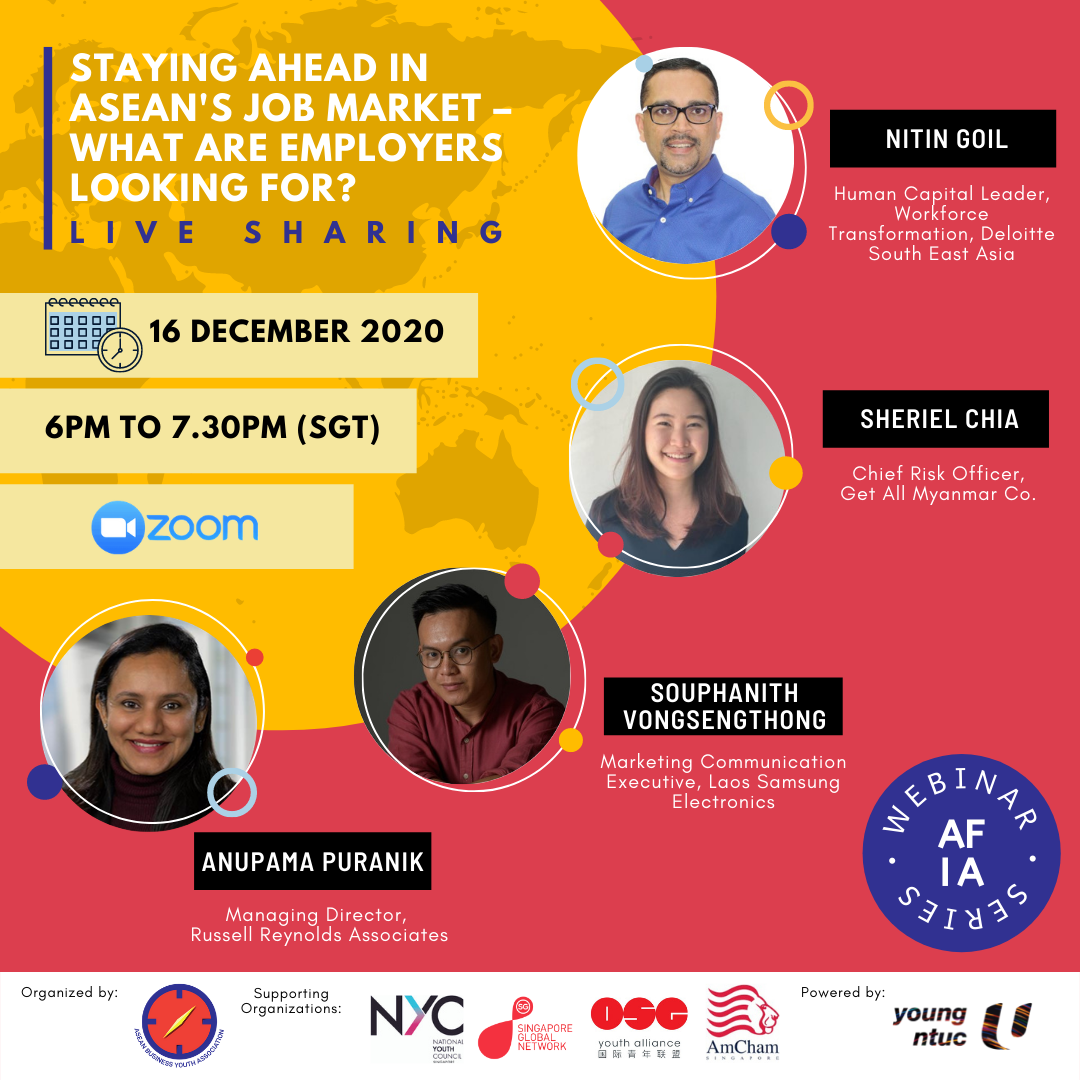
On November 15, ASEAN Business Youth Association co-hosted a webinar with the National Youth Council Singapore (NYC) on the topic of ‘Propelling the Enterprising Spirit in ASEAN’. The webinar is part of ABYA’s monthly webinar series and NYC’s Asia-Ready webinar series under the Asia-Ready Exposure Programme (AEP). The panel comprised of Mr Vincent Ha, CEO & Co-Founder of Lyte Ventures and Chairman & Co-Founder of Gushcloud International; Ms Kanpassorn Suriyasangpetch (Eix), CEO & Co-Founder of OOCA; and Mr Rithy Thul, Co-Founder of SmallWorld & CEO of Koompi. The sessions were moderated by Ms Mala Rajpal, Founder of Left Right SG and Programme Lead Youth Engagement & Events of UNDP Global Centre, Singapore.
Written by: Clarence Ng Kai Lun
Edited by: Soon Poh Suan & Isabelle Goh
The speakers shared about their own personal journey as an entrepreneur and emerging opportunities in the ASEAN region for budding entrepreneurs.
A strong sense of purpose
During the panellists’ sharing of their personal journey as an entrepreneur, a common and strong sense of purpose lies behind their enterprising spirit. From their perspectives, a clear notion of ‘why’ is crucial in sustaining their enterprising passions.
As a parent, Vincent shared his worries of how the future of work affects his own children. He observed an increasing trend of freelancing, especially in the social media space. Freelancers face greater instability and limited access to traditional financial services. For example, to access bank loans, traditional banks often require an official payslip. This requirement excludes freelancers since they do not receive regular income. Therefore, Vincent worked to establish an ecosystem to support the growth of influencers in the social media marketing industry and a financial tech solution to make financial services more accessible for freelancers.
Eix is not your typical entrepreneur. She was trained as a dentist and was on track to become a surgeon. She had a stable and valuable career in Thailand. At the same time, in conservative Thailand, mental health services are scarce and seeking help still invites stigma. Hence, when she faced challenges of getting help for mental health in Thailand, she became determined to come up with a solution to make mental health support accessible. She eventually gave up her stable career path to focus fully on developing a telehealth service for mental health support.
Finally, Rithy also shared his purpose behind his work. He hopes to empower the next generation to solve issues that his generation cannot solve, and he believes the future lies in technological solutions. To this effect, one of his initiatives is to make technology accessible to students enmasse in Cambodia through the distribution of laptops equipped with open software necessary to learn different technological skills. Illustrating the importance of having a clear purpose, he shared how by having a clear vision and idea, he managed to convince a landlord to rent a space to him at a cheaper rate and advance a loan at the same time.
Trends across ASEAN
The entrepreneurship class in ASEAN is rising and for these budding entrepreneurs, our panellists highlighted three trends to take note of.
First, ASEAN is a diverse and complicated region. Each country has its own unique culture, history and language. Also, ASEAN’s rapid development and an emerging economy is attracting interest from businesses. However, ASEAN’s diversity poses significant challenges for foreign businesses as they enter the ASEAN market. Local Southeast Asian entrepreneurs tend to have an advantage over foreign competitors — in navigating the complexities of Southeast Asia due to their familiarity within the region. Furthermore, ASEAN provides local entrepreneurs with a unique opportunity to plug the gap between the East and West.
Second, Singapore and the rest of ASEAN have a symbiotic relationship in terms of entrepreneurship. It may be hard for entrepreneurs to seek capital in ASEAN countries apart from Singapore. Eix shared her difficulties looking for investors with proper venture capital experience in Thailand. On the other hand, focusing on the Singapore market alone may pose a limitation for local entrepreneurs. Vincent had also described a challenge for local entrepreneurs, in being able to find the right market outside of Singapore for their business. Hence, he encourages potential entrepreneurs to explore other ASEAN countries. This symbiotic relationship is strengthened by increasing webs of networks and connections across ASEAN, supported by trade infrastructures. For example, cross national financing is easier than ever, and many start-ups in the region can seek funding in Singapore.
Finally, despite the diversity of ASEAN, many ASEAN countries share common developmental problems. Hence, it is easy for entrepreneurs to export their solutions to other ASEAN nations. Rithy suggests that aspiring entrepreneurs should first focus on developing a strong solution in one market, seeing through its execution, and establishing a strong presence. Thereafter, with the help of the strong network of entrepreneurs in ASEAN, the solution can be swiftly replicated across other countries in ASEAN.
Closing Note
Overall, the speakers shared the purpose behind their drive and passions and broad trends in entrepreneurship across ASEAN. With the booming industries of emerging technology and digital access, the ASEAN region is a growing market with invaluable learning opportunities to the young population.
Thank you to the speakers for your insights and to our members for tuning in. We would also like to thank our co-organizers, NYC and our supporting organizations, for their continued support for ABYA.
If you are a youth looking for AEP opportunities, visit go.gov.sg/aepprog to find out more!



